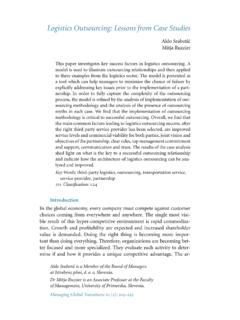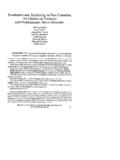Transcription of Teachers’ Continuing Professional Development: A New …
1 Teachers' Continuing Professional development : A New Approach Jo Rose, University of Exeter David Reynolds, University of Plymouth The concept of Continuing Professional development (CPD) in education is often ill-defined, with the separate notions of formal training and on-the job learning serving to confuse the issue further. However, Day's (1999) definition of CPD encompasses all behaviours which are intended to effect change in the classroom: Professional development consists of all natural learning experiences and those conscious and planned activities which are intended to be of direct or indirect benefit to the individual, group or school, which contribute, through these, to the quality of education in the classroom. It is the process by which, alone and with others, teachers review, renew and extend their commitment as change agents to the moral purpose of teaching; and by which they acquire and develop critically the knowledge, skills and emotional intelligence essential to good Professional thinking, planning and practice with children, young people and colleagues throughout each phase of their teaching lives.
2 (Day, 1999, ). Teachers' perceptions of what activities constitute CPD is frequently limited to attendance at courses, conferences and whole-school INSET days, often to meet national requirements. Professional learning, or on the job learning is regularly seen by teachers as separate from CPD, and something that is just done as part of the job (Edmonds and Lee, 2002; Hustler et al, 2003; Robinson and Sebba, 2004). However, the literature points to several facets of effective CPD, many of which are far removed from the commonly-held perceptions of CPD. as one-off events. Models of CPD. Lieberman (1996) classified CPD into three types: direct teaching (such as courses, workshops and so on); learning in school (such as peer coaching, critical friendships, mentoring, action research, and task-related planning teams); and out of school learning (such as learning networks, visits to other schools, school-university partnerships and so on).
3 Kennedy (2005) described nine models of CPD, which are outlined below. Training - focuses on skills, with expert delivery, and little practical focus Award Bearing usually in conjunction with a higher education institution, this brings the worrying discourse on the irrelevance of academia to the fore Defecit - this looks at addressing shortcomings in an individual teacher , it tends to be individually tailored, but may not be good for confidence and is unsupportive of the development of a collective knowledge base within the school Cascade this is relatively cheap in terms of resources, but there are issues surrounding the loss of a collaborative element in the original learning Standards Based this assumes that there is a system of effective teaching, and is not flexible in terms of teacher learning. It can be useful for developing a common language but may be very narrow and limiting Coaching / Mentoring the development of a non-threatening relationship can encourage discussion, but a coach or mentor needs good communication skills 219.
4 Community of Practice these may inhibit active and creative innovation of practice, although they have the potential to work well through combining the knowledge bases of members Action Research This is relevant to the classroom, and enables teachers to experiment with different practices, especially if the action research is collaborative. Transformative the integration of several different types of the previous models, with a strong awareness and control of whose agenda is being addressed Kennedy suggested that the first four of these were essentially transmission methods, which give little opportunity for teachers to take control over their own learning. The following 3 are more transformational, giving an increasing capacity for Professional autonomy, with the action research and transformative models being able to provide even more Professional autonomy, and giving teachers the power to determine their own learning pathways.
5 Direct teaching or training, the traditional perception of CPD, is often perceived as a top- down delivery model of CPD, where information on methods is passed on to teachers for them to implement. Such lecture-style teaching has proved unpopular with teachers, who tend to prefer more active and practical styles of learning (Edmonds and Lee, 2002). Dadds (1997). described how such top-down delivery could reinforce the idea of the teacher as a technician, uncritically implementing externally imposed policies. Dadds rejected the idea of a guru culture , with teachers being told how to teach by the experts, and instead suggests that teachers see themselves as a resource, and use their own experience and background to develop their own critical and reflective practice over the course of their Professional lives. An awareness of less formal and traditional forms of CPD is slowly growing, with calls for teachers to become more creative in their approaches to their own Professional development , and move away from more traditional transmission-based methods (Muijs et al, 2004).
6 Peer Support While few teachers would want to completely forgo expert advice , it is evident from the literature that common features of successful CPD include a variety of methods. Recommendations highlight that CPD should no longer be comprised solely of short courses;. teachers need opportunities to reflect, engage in Professional dialogue, work with pupils, and engage in peer observation, coaching and feedback (Livneh & Livneh, 1999). In their review of collaborative CPD, Cordingley et al (2003) noted a number of features of successful interventions, including classroom observation and feedback; consultation with experts from outside the school in conjunction with internal peer support; encouraging, extending and structuring Professional dialogue; teachers having ownership of their CPD focus; an emphasis on peer support rather than a top-down managerial approach; and sustained support for CPD.
7 To allow for new practice to become established. The opportunity to observe other teachers, and to be observed has long been acknowledged as a beneficial process, and observation is now seen as an integral part of coaching and sustained learning (Da Costa, 1993; Joyce and Showers, 2002). The process of observation and feedback facilitates discussion and exchange of practical and relevant ideas, which many teachers report as being crucial to the fruitfulness of the CPD experience (Armour and Yelling, 2004; Cordingley et al, 2005b; Edmonds and Lee, 2002; Hustler et al, 2003). However, it is important that such activities take place within the context of secure and trusting relationships (Fielding et al, 2005; Wood and Anderson, 2003), particularly in the 220. current climate where classroom observations are so closely associated with the stressful evaluation of OFSTED inspections.
8 Extending peer observation and discussion to peer coaching and mentoring is increasing in popularity. The opportunity to discuss and experiment with new ideas, and receive feedback is seen as useful (Gersten et al, 1995). Many projects have shown that, with training for mentors, this type of process can be effective in improving practice for both the coach /. mentor and the coached / mentored ( Cordingley, 2003, 2005a; Jones and Moor, 2005;. Joyce and Showers, 2001). Peer coaching has been found to work extremely well when used in conjunction with classroom observation (Da Costa, 1993), with the coach either teaching and being watched, or observing (Livneh and Livneh, 1999). Modelling of techniques and methods is often appreciated by teachers (Harvey, 1999; Kimmel et al, 1999). Cochran-Smith and Lytle (1999) describe three types of knowledge: for practice knowledge , or the use of formal theory about practice; in-practice knowledge , or the use of interaction and communicating in teaching; and of practice knowledge , or the awareness of knowledge- generation which tends to be beneficial for teachers in directing their own learning.
9 They suggested that those teachers who have strong in-practice knowledge , and are very good at interaction and the practice of teaching, tend to make good coaches. A strong subject and pedagogy knowledge is essential in a successful coach, although the hierarchical nature of a relationship where the coach is more experienced than the coached may hinder the development of a secure and trusting relationship that allows for open discussion (Fielding et al, 2005). Peer support and collaboration plays many roles. Many teachers are likely to be more comfortable discussing their practice with peers than with senior management, where issues surrounding performance management may hinder honest and open discussion (eg Kennedy, 2005). When there has been input from outside the school, Continuing peer support can provide a forum for discussion which would not be so easy to access were teachers entirely reliant on the outside expertise (Livneh and Livneh, 1999), with the additional benefits that come with familiarity of context.
10 A supportive, blame-free environment that encourages and facilitates Professional dialogue, and provides opportunities to extend and experiment with new practice can further the benefits of peer collaboration and support (Eraut, 2001). While peer observation is currently evolving into programmes of peer coaching and mentoring, there is little evidence in the literature that any further CPD activities or practices are based on the findings of such observation. Tailoring external support, and collaborative activities, to what is happening in the classroom before any input or activities does not seem to have been adequately explored as an approach for Professional development , and this paper explores the development of a link between classroom practice and CPD provision. External Support The use of external expertise can result in provision of knowledge and ideas, and be useful in terms of the external expert acting as a catalyst for and agent of change.
















